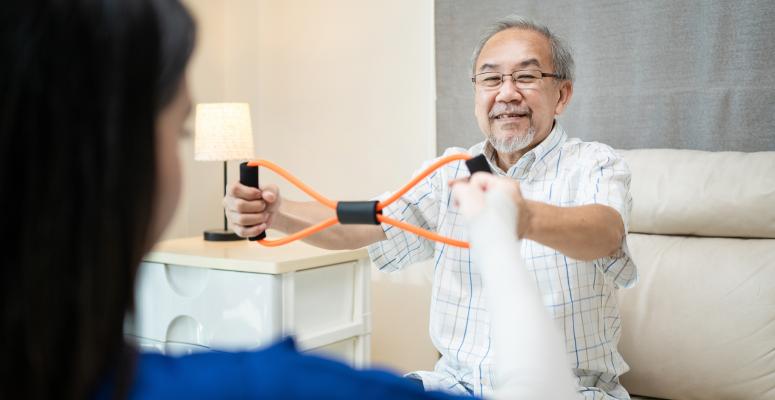

Physical therapy can be a great resource that helps people to manage pain, recover from injuries or illnesses and live more independent lives. However, we understand that many barriers could prevent a person from seeking physical therapy. For instance, people with compromised immune systems may feel unsafe commuting to an in-person clinic. People with limited mobility or lack of transportation may not even have a choice. That's why Alliance offers at-home physical therapy care.
Our at-home physical therapy services give you access to quality, one-on-one treatment in the comfort of your home. Whether you are unable to make it to the office or prefer not to commute, we're here to help.
Conditions We Treat
Our therapists are available to treat you for most of the same conditions in your home that you can be treated for in our clinics. Our goals in at-home treatment are the same as in our office: to help patients manage their pain symptoms so they can live comfortably and independently.
Here are some of the ailments we’re available to treat:
- Knee pain — ACL injuries, torn meniscus, etc.
- Back pain — Degenerative disc disease, spinal stenosis, etc.
- Foot and ankle pain — Achilles tendon ruptures, tendinitis, etc.
- Shoulder pain — Rheumatoid arthritis, rotator cuff tears, etc.
- Hand and wrist pain — Carpal tunnel syndrome, repetitive strain injuries, etc.
- Neck pain — Whiplash, bone spurs, etc.
- Hip pain — Bursitis, labral tears, hip flexor injuries, etc.
- Arthritis — All types, including rheumatoid, osteoarthritis, and more
- Balance and gait disorders — Neurological disorders, vertigo, and other conditions causing a fall risk.
Please note that the list above is not exhaustive. Contact us today if you are curious about our at-home physical therapy services.
What to Expect During Treatment
Our at-home sessions are very similar to our in-office sessions. However, you may not have access to the same equipment you'd have access to in an Alliance clinic. That said, your therapist may bring portable equipment, such as an exercise ball, light weights or manual therapy instruments for your session.
After a brief interview about your medical history and symptoms and an assessment of your physical condition (posture, gait, etc.), they will determine a course of action for treatment. Your treatment plan may include a combination of the following:
Exercise — Your physical therapist will walk you through a series of exercises to help you strengthen your bones and muscles. This can help limit the pain you feel as you perform daily tasks.
Targeted stretching — Stretching helps improve your soft tissue's flexibility and mobility, which can relieve some of your pain symptoms.
Manual therapy — Manual therapy is a technique clinicians use to relieve tension in your joints and muscles physically. They may use their hands or special instruments, but manual therapy can relieve pain and help you move more comfortably.
Ergonomic screenings — If your pain symptoms stem from your job or certain motions performed repetitively in your daily life, your physical therapist may coach you on how to perform those activities more safely. They may also suggest that you modify your furniture or work equipment (i.e., office chair) to make it more friendly to your bones and muscles.
Our at-home physical therapy services are available through many of our clinics. Visit our Locations page to find a clinic in your area.
